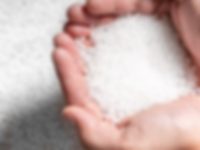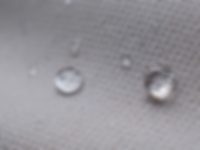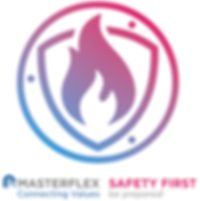Chemical resistant hoses
Hoses made of chemical-resistant fabrics
PTFE, Viton®, Kapton® or Hypalon®, you are definitely on the safe side when conveying media under hazardous conditions. In the chemical industry in particular, the safety of a hose line is of central importance, because substances with very different hazard characteristics have to be transported there.
MaterialsConstrution & Manufacturing
When it comes to connecting portable fittings or transporting chemical gases, flexible and quick-to-use connection solutions, such as our clip hoses, can offer unbeatable advantages. What's more, many of the hoses mentioned here are also suitable for use in potentially explosive atmospheres.
Our safety and quality requirements, as well as our experienced staff, enable you to find exactly what you are looking for.
Materials we use for chemical resistant hose types.
For the production of clip hoses we use reliable types of fabrics, which differ from each other in their properties. Depending on the substances, gases or liquids to be transported, the required temperature ranges or the expected mechanical loads. We have a wide range of high-quality technical fabrics and knitted fabrics made of glass, polyamide, polyester as well as aramid fibers such as Nomex® or Kevlar® and even ceramic material at our disposal. Special rubbers such as silicone, Neoprene® and CSM and special elastomers such as Viton®, Nitril® or butyl are used for the coating. Many types of fabric are particularly heat resistant, enabling them to be used in high-temperature applications.
Material resistance to flow-through substances
Not only internal or external mechanical effects can damage a hose line. Physical and chemical effects can also have a negative impact on a hose. This is always the case when liquid or gaseous substances penetrate the hose material, act on it or react with it. Our hoses are resistant to chemicals, as we manufacture many clip hoses from particularly chemical-resistant fabrics such as PTFE, Viton®, Kapton® or Hypalon®.

Material PE
Polyethylene (PE) is a thermoplastic and very durable due to its high resistance to acids, alkalis and chemicals. The material also has harder material properties. Polyethylene hoses are particularly suitable for demanding applications, for example for transporting aggressive gaseous and liquid media or for conveying fine-grained particles such as dusts and powders in the chemical sector. The PE material is particularly resistant to acetone, benzene, toluene and xylene.
Further information on the material can be found on our product detail pages.

Material PTFE
Let's move on to the performance material PTFE. We equip individual, multilayer clip hoses with an inner layer made of an electrically conductive PTFE film. Since this wall material is anti-adhesive or non-adhesive, these hoses offer virtually optimum conditions for transporting different media. Furthermore, the high-performance material PTFE is characterized by an almost universal chemical resistance.
Further information on the material can be found on our product detail pages.

Design and manufacturing process of chemical resistant hoses
We can design hoses from film, extrusion and clip. The widest product range for a chemical resistant hose is our clip hoses. For the production of clip profile hoses, we use film or fabric strips and a clamping profile ("clip"). In the clip process, different materials suitable for the production of a hose wall are clamped together with a metal spiral to form a tension-resistant hose. This process involves no welding, gluing or sewing. Depending on the external or internal stresses, the hoses can also be manufactured in multiple layers, and with their outer spiral, clamping profile hoses also have a "built-in" protective profile. The design also includes the abrasion protection spiral, which protects the hose from abrasion and mechanical damage.
Notes on chemical resistant hoses
Many of the hoses mentioned in this group have been designed, engineered and manufactured by us for specific requirements and operating conditions. And similarly to the great efforts we make to provide precisely fitting and safe solutions for defined operating conditions, you should also take great care to ensure that you use the hoses you select in accordance with their technical specification. So even when selecting a hose assembly, you should know as well as possible the mode of operation you intend to use later. After all, you will only be able to install a connection solution effectively and safely if you take your (process engineering) processes and operational relationships into account.
Parameters for application requirements:
- Resistance to the flow substances
- Operating pressure (static and dynamic)
- Operating temperature
- Installation situation
- frequency of bending/bending cycles (dynamic stress)
- frequency and duration of use
- possible alternating stress (pressure, temperature)
- environmental conditions
- mechanical stress
Standards for chemical resistant hoses
In addition to the Ordinance on Industrial Safety and Health, TRGS 727 (TRGS= Technical Rules for Hazardous Substances) and the ATEX Product Directive 2014/34 EU are also decisive for the assessment and avoidance of ignition hazards. In terms of safety, therefore, the ATEX standard applies.
More about qualityList for chemical resistance

Background knowledge: Dust explosion
When transporting solids or even when dragging them across the floor, hose lines can become electrostatically charged during operation. The charge can reach such a high level of energy that ignition hazards are imminent and safety is endangered. For example, when coupling the hose line, a spark can be generated that causes an explosive mixture to ignite.
We have written a white paper on the subject of dust explosions.



















